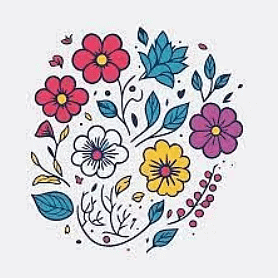Worksheet Solutions: A Beautiful Cloth - 2 | EVS for Class 3 PDF Download
Q1: Multiple Choice Questions (MCQs).
(i) What did Sajida use to make designs on cloth in 'The Plant Fairy'?
(a) Cut vegetables
(b) Pencil
(c) Chalk
(d) Glue
Ans: (a)
Sajida used cut vegetables to make designs on cloth in 'The Plant Fairy'.

(ii) What did Sajida do with the Dupatta after playing with it?
(a) She went out to play
(b) She fell asleep while wearing it
(c) She started reading a book
(d) She started cooking
Ans: (b)
After playing with the Dupatta, Sajida fell asleep while still wearing it.
(iii) What is the first step in the process of weaving paper?
(a) Cutting the paper
(b) Drawing lines on the paper
(c) Stacking the papers
(d) Weaving the strips
Ans: (b)
The first step in the process of weaving paper is drawing lines on it.
(iv) What did Sajida receive from her sister?
(a) A beautiful dress
(b) A decorated scarf
(c) A beautiful dupatta
(d) A pair of shoes
Ans: (c)
The passage mentions that Sajida received a beautiful dupatta from her sister.
(v) What did Sajida receive from her sister?
(a) A beautiful dress
(b) A decorated scarf
(c) A beautiful dupatta
(d) A pair of shoes
Ans: (b)
The passage states that the dupatta was embellished with beautiful embroidery and small mirrors.
Q2: Fill in the Blanks.
(i) Sajida received a beautiful __________ from her sister.
Ans: Dupatta
(ii) The Dupatta Sajida received had beautiful __________ and small mirrors.
Ans: embroidery
(iii) After cutting a vegetable, you should __________ the cut face and make prints.
Ans: paint
(iv) To make the paper mat, you need to weave the strips of paper _______.
Ans: together
(v) The lesson 'The Plant Fairy' featured designs of flowers and leaves made on _______.
Ans: cloth
Q3: True or False.
(i) Sajida went out to play after she became tired of playing with the Dupatta.
Ans: False
Sajida actually fell asleep while wearing the Dupatta after she became tired of playing with it.
(ii) The first step in weaving paper is to stack the papers.
Ans: False
The first step in weaving paper is actually to draw lines on the paper.
(iii) You can use cut vegetables to make designs on cloth.
Ans: True
Yes, you can use cut vegetables like cauliflower or lady finger to make designs on cloth.
(iv) The activity involving paper weaving is about making origami animals.
Ans: False
The passage describes making a paper mat using strips of paper, not origami animals.
(v) The Plant Fairy lesson showcased designs of flowers and leaves made on paper.
Ans: False
The passage mentions designs made on cloth, not paper, in 'The Plant Fairy' lesson.
Q4: Answer the following Questions.
(i) Take a dupatta or a long piece of unstitched cloth. Drape it in different ways. In how many ways, could you wear it?
Ans: Women can wear the dupatta with traditional Indian attire such as salwar kameez or lehenga. It can also be worn as a scarf or a stole over a Western outfit. Men, on the other hand, can wear it as a turban, dhoti, or wrap-around outfit.
(ii) Look at any six garments at home. What differences do you find in their texture, color, and design?
Ans: These are the differences I've noticed at home between the six different garments:
- Some garments are brightly coloured, while others are fully coloured.
- A rough texture can be found on some garments, while others have a smooth texture and finish.
- Some garments have a detailed, intricate design, while others have a simple design.
(iii) How do you think Sajida’s dupatta was made?
Ans: Sajida's dupatta is made of woven fabric, either by hand or by machine.
(iv) Did anyone wear it like a lungi or use it as a turban? In what other ways was the cloth worn?
Ans: Yes, it can be worn as a lungi, dhoti, or turban by men. It can be worn over a salwar kameez or lehenga and can be worn like a sari with small pleats.
(v) Look at a thick cloth or a sack carefully. Can you see threads running along its length and breadth? You will find a similar pattern if you see any piece of cloth closely.
Ans: Yes, the threads can be seen running the length and breadth of the cloth. When I examined another piece of cloth closely, I noticed a similar pattern.
|
45 videos|182 docs|48 tests
|
FAQs on Worksheet Solutions: A Beautiful Cloth - 2 - EVS for Class 3
| 1. What is the significance of a beautiful cloth? |  |
| 2. How can I choose the right cloth material for my needs? |  |
| 3. What are some popular cloth patterns and designs? |  |
| 4. How can I take care of a beautiful cloth to ensure its longevity? |  |
| 5. Where can I find a wide variety of beautiful cloth options? |  |
















